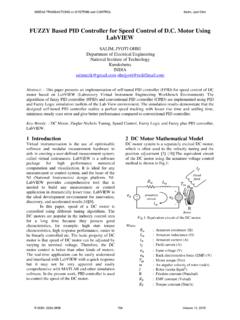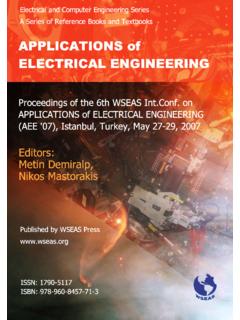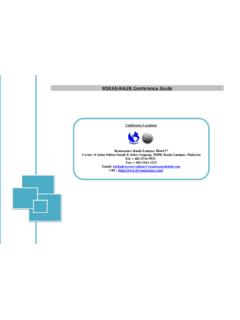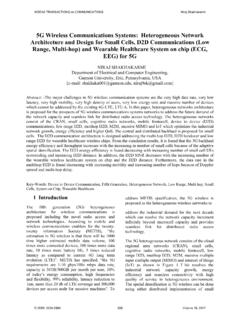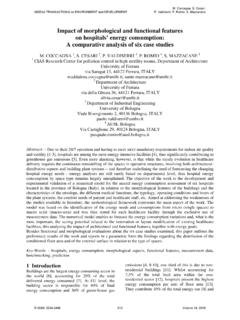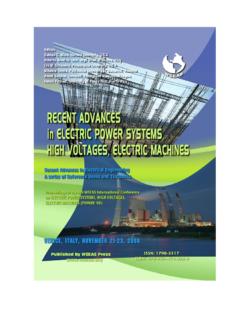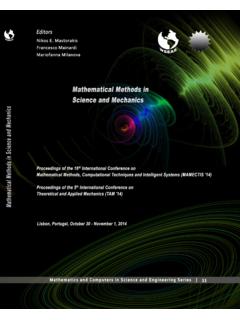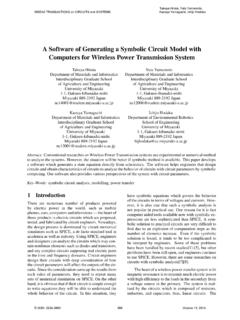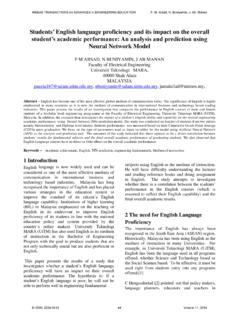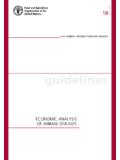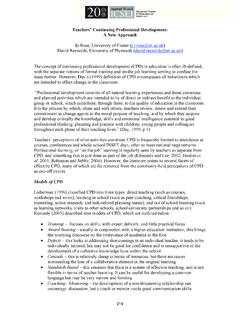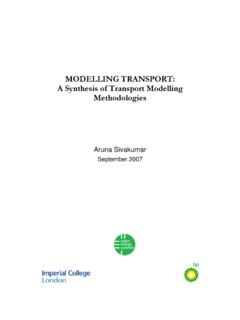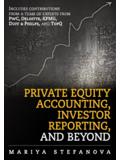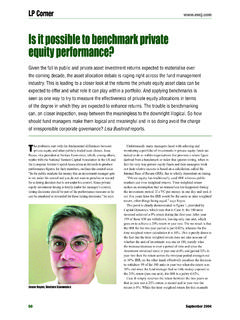Transcription of COMPUTATIONAL ENGINEERING - wseas.org
1 COMPUTATIONAL ENGINEERING in SYSTEMS APPLICATIONS (Volume II) Proceedings of International Conference on Energy, Environment, Economics, Devices, Systems, Communications, Computers Iasi, Romania July 1-3, 2011 ISBN: 978-1-61804-014-5 ISSN: 2223-9812 COMPUTATIONAL ENGINEERING in SYSTEMS APPLICATIONS (Volume II) Proceedings of International Conference on Energy, Environment, Economics, Devices, Systems, Communications, Computers Iasi, Romania July 1-3, 2011 Published by IAASAT Press Copyright 2011, by IAASAT Press All the copyright of the present book belongs to the IAASAT Press. All rights reserved. No part of this publication may be reproduced, stored in a retrieval system, or transmitted in any form or by any means, electronic, mechanical, photocopying, recording, or otherwise, without the prior written permission of the Editor of IAASAT Press.
2 All papers of the present volume were peer reviewed by two independent reviewers. Acceptance was granted when both reviewers' recommendations were positive. See also: ISBN: 978-1-61804-014-5 ISSN: 2223-9812 International Authority for the Advancement of Science and Applications of Technology The Alexandru Ioan Cuza University of Iasi COMPUTATIONAL ENGINEERING in SYSTEMS APPLICATIONS (Volume II) Proceedings of International Conference on Energy, Environment, Economics, Devices, Systems, Communications, Computers Iasi, Romania July 1-3, 2011 Editors: Prof. Nicu Gavriluta, The Alexandru Ioan Cuza University of Iasi, Romania Prof. Razvan Raducanu, The Alexandru Ioan Cuza University of Iasi, Romania Prof.
3 Mihaiela Iliescu, Politehnica University of Bucharest, Romania Prof. Hariton Costin, Popa University of Medicine and Pharmacy, Romania Prof. Nikos Mastorakis, Technical University of Sofia, Bulgaria Prof. Vladimir Olej, University of Pardubice, Czech Republic Dr. Jiri Strouhal, University of Economics Prague, Czech Republic Prof. Alina Barbulescu, Ovidius University of Constanta, Romania Prof. Mihaela Costin, Romanian Academy, Romania International Program Committee Members: Lotfi Zadeh, USA Tadeusz Kaczorek, POLAND Metin Demiralp, TURKEY Zoran Bojkovic, SERBIA Aida Bulucea, ROMANIA Valeri Mladenov, BULGARIA Ezendu Ariwa, UK Dimitris Bertsekas, USA Cain Evans, UK V. A. Pereira Marinho Marques, PORTUGAL Olga Martin, ROMANIA Table of Contents Plenary Lecture 1: Further Trends in Fourth Generation Mobile Systems: Convergence, Quality of Service, Security and Applications 10 Zoran Bojkovic Plenary Lecture 2: Computer Support for CLIL - Content and Language Integrated Learning 11 Suzana Carmen Cismas A Shock Filter of a Vibratory Signal for Damage Detection 13 Bechir Badri, Marc Thomas, Sadok Sassi Overview on Adams Implementation 18 Razvan Popescu, Ivona Potzaichin, Graziela Vajiala Doping Testing Programs 22 Graziela Vajiala, G.
4 Andreiasu, C. Berbecaru, Ivona Potzaichin, Claudia Berbecaru Modelling the Configuration and Dynamics of Urban Space 26 Gerda Hartl, Georg Franck Modeling of Economic and Environmental Impacts of Energy Generation using of Waste Paper 31 Robert Bata Operating Company's Performance Through Managers/ Eyes in the Czech Republic 37 Bohuslava Knapova National and Local Regulations Regarding Wind Parks 42 Florin Fainisi Modelling the Environmental Impacts of a Biomass Based Electric Power Generation 47 Robert Bata, Pavla Pulkrabkova Accounting Policies and Options Regarding the Amortization Period A Comparative Study in the IFRS Practice and Romanian Accounting 54 Marinela-Daniela Manea Application for Regenerative Dentistry: The Collagen Matrices with Lidocaine 60 Laura Cristina Rusu, Cosmin Sinescu, Meda Lavinia Negrutiu, Lavinia Cosmina Ardelean, Alexandru Ogodescu, Mihai Fabricky, Emanuela Petrescu, Roxana Otilia Rominu, Florin Topala, Mihai Rominu, Madalina Georgiana Albu, Mihaela Violeta Ghica, Adrian Gh.
5 Podoleanu Natural Products Optimized Separation Parameters 65 Eugenia Eftimie Totu, Elena Ruse, Ioana Diaconu COMPUTATIONAL ENGINEERING in Systems Applications (Volume II)ISBN: 978-1-61804-014-57 Renewable Energy Sources as Important Factor of the Long-Term Sustainable Development Concept in the Republic of Serbia 69 Srdjan Zikic Renewable Energy Risk Management 74 Petre Lucian Seiciu An Intelligent Approach for Constructing Domain Ontology Using Art2 Neural Network and C-Value Method 79 Maryam Hourali, Gholam Ali Montazer Experimental Models of Electro-Conductivity and Productivity Agricultural Maps for the Cambic Chernozem Soil 89M. Matache, I. Voicea, V. Vladut, I. Pirna, S. Bungescu, C. Chirila Vegetal Biomass, A Renewable Source for Obtaining of Clean Energy 96M.
6 Matache, V. Vladut, A. Danciu, I. Voicea, I. Pirna, E. Postelnicu, C. Chirila Self-Learning Fuzzy SVC Controller for Oscillations Damping 101N. Magaji, M. W. Mustafa Evaluating GAIA Methodology in Agent-Oriented Software ENGINEERING 107 Amin Farahbakhsh Tooli, Javad Asadi Hierarchical Knowledge in Image Processing: Data-flow Chart and Cognitive Advances 114 Mihaela Costin A Grid Service for Multi-Spectral Vegetation Indices Estimation 120 Cristina Serban Gherghina, Carmen Maftei, Cosmin Filip Using NI LabVIEW to Automate Analyses of Water Flow to a Subsurface Drain in a Layered Soil 125 Constantin Buta, Carmen Maftei, Cornel Ciurea, Cosmin Bucur, Lucian Balasa GPD Models for Extreme Rainfall in Dobrudja 131 Judicael Deguenon, Alina Barbulescu, Makhtar Sarr The Current Financial Crisis.
7 Visible and Invisible Connections with Food Crisis 137 Mioara Chirita, Simona Valeria Toma, Daniela Ancuta Sarpe Educational Framework Model for Image Processing and Image Databases 143 Mocofan Muguras, Sorin Petan, Radu Vasiu Simulation Effects on E-Business Transformations 147 Shapoor Zarei, Nikos E. Mastorakis, Amin Daneshmand Malayeri Functional Simulation of Harmonic Drive with Wave Generator 161 Viorel-Ionut Bizau, Ion Vela, Ovidiu Milos, Alina Visan, Ion-Cornel Mituletu COMPUTATIONAL ENGINEERING in Systems Applications (Volume II)ISBN: 978-1-61804-014-58 Design and Measurement of Driver Amplifier for IEEE Mobile WiMAX using a Small-Signal Method 166S. Kassim, F. Malek Modified Adaptive Load Shedding 171H. A. Rakhshani, A. R. Heidari, M. M. Kaykha Thin-Walled Steel Sheets with Indentations in Composite Steel-Concrete Structure under Different Types of Loading 177 Josef Holomek, Radek Karasek, Miroslav Bajer, Jan Barnat Ageing Behavior of Friction Stir Welding AA7075-T6 Aluminum Alloy 183T.
8 Azimzadegan, Gh. Khalaj, M. M. Kaykha, A. R. Heidari Linearization of Three-Stage Doherty Amplifier 188 Natasa Males Ilic, Aleksandar Atanaskovic, Bratislav Milovanovic RRTs Review and Options 194 Ahmad Abbadi, Radomil Matousek, Petr Minar, Petr Soustek Authors Index 200 COMPUTATIONAL ENGINEERING in Systems Applications (Volume II)ISBN: 978-1-61804-014-59 Plenary Lecture 1 Further Trends in Fourth Generation Mobile Systems:Convergence, Quality of Service, Security and Applications Professor Zoran Bojkovic Full Prof. of Electrical ENGINEERING University of Belgrade, Serbia E-mail: Abstract: In fourth generation 4G system concept, the user has freedom and flexibility to select any desired service with reasonable quality of service QoS and affordable price, any time, are many attractive features for 4G which ensure a very high data rate, global roaming, incorporating the mobile world into the Internet Protocol IP-based core network, establishing an efficient billing system and perfect handoff mechanisms.
9 Improvements over the third generation 3G include enhanced multimedia, smooth streaming video, universal access and portability across all types of devices. Migrating current systems to 4G presents enormous challenges. Current systems must be implemented with a view to facilitate a seamless integration into 4G infrastructure. Today 4G is a convergence platform providing clear advantages in terms of coverage bandwidth and power consumption. It offers a variety of new heterogeneous services. All these characteristics are supported by multimode/reconfigurable devices and implementation of interworking ones. 4G mobile communication networks are expected to provide all IP-based services for heterogeneous wireless access technologies, assisted by mobile IP to provide seamless Internet access for mobile for QoS and security support in 4G networks integrate signaling with authentication, authorization and accounting AAA services to guarantee the user applications, QoS requirements and achieve efficient AAA.
10 An integrated service and resource management approach is based on the cooperative association among QoS brakers,AAA, and charging systems. Seamless vertical handover VHO is an important function of beyond 3G systems. Concept transfer can help support seamless VHO, while maintaining the raquired security level. This presentation is organized as follows. After the introduction showing mobile system generation together with short history of mobile technologies,including various existing and emerging wireless technologies, the next section deals with converging of high speed Inernet and mobility as a major drivers of future wireless. Design objectives are also presented. The second part describes network selection with most appropriate selection criteria (service type, available resources, user content ).
